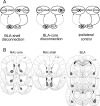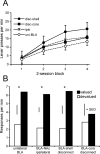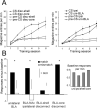At the limbic-motor interface: disconnection of basolateral amygdala from nucleus accumbens core and shell reveals dissociable components of incentive motivation
- PMID: 21044174
- PMCID: PMC2994582
- DOI: 10.1111/j.1460-9568.2010.07439.x
At the limbic-motor interface: disconnection of basolateral amygdala from nucleus accumbens core and shell reveals dissociable components of incentive motivation
Abstract
Although it has long been hypothesized that the nucleus accumbens (NAc) acts as an interface between limbic and motor regions, direct evidence for this modulatory role on behavior is lacking. Using a disconnection procedure in rats, we found that basolateral amygdala (BLA) input to the core and medial shell of the NAc separately mediate two distinct incentive processes controlling the performance of goal-directed instrumental actions, respectively: (i) the sensitivity of instrumental responding to changes in the experienced value of the goal or outcome, produced by specific satiety-induced outcome devaluation; and (ii) the effect of reward-related cues on action selection, observed in outcome-specific Pavlovian-instrumental transfer. These results reveal, therefore, that dissociable neural circuits involving BLA inputs to the NAc core and medial shell mediate distinct components of the incentive motivational processes controlling choice and decision-making in instrumental conditioning.
© 2010 The Authors. European Journal of Neuroscience © 2010 Federation of European Neuroscience Societies and Blackwell Publishing Ltd.
Figures





Similar articles
-
The role of the nucleus accumbens in instrumental conditioning: Evidence of a functional dissociation between accumbens core and shell.J Neurosci. 2001 May 1;21(9):3251-60. doi: 10.1523/JNEUROSCI.21-09-03251.2001. J Neurosci. 2001. PMID: 11312310 Free PMC article.
-
The basolateral amygdala differentially regulates conditioned neural responses within the nucleus accumbens core and shell.Neuroscience. 2010 Sep 1;169(3):1186-98. doi: 10.1016/j.neuroscience.2010.05.073. Epub 2010 Jun 4. Neuroscience. 2010. PMID: 20570714 Free PMC article.
-
Nucleus Accumbens Core and Shell Differentially Encode Reward-Associated Cues after Reinforcer Devaluation.J Neurosci. 2016 Jan 27;36(4):1128-39. doi: 10.1523/JNEUROSCI.2976-15.2016. J Neurosci. 2016. PMID: 26818502 Free PMC article.
-
Learning and Motivational Processes Contributing to Pavlovian-Instrumental Transfer and Their Neural Bases: Dopamine and Beyond.Curr Top Behav Neurosci. 2016;27:259-89. doi: 10.1007/7854_2015_388. Curr Top Behav Neurosci. 2016. PMID: 26695169 Review.
-
Ventral striatal control of appetitive motivation: role in ingestive behavior and reward-related learning.Neurosci Biobehav Rev. 2004 Jan;27(8):765-76. doi: 10.1016/j.neubiorev.2003.11.015. Neurosci Biobehav Rev. 2004. PMID: 15019426 Review.
Cited by
-
Modulation of methamphetamine memory reconsolidation by neural projection from basolateral amygdala to nucleus accumbens.Neuropsychopharmacology. 2023 Feb;48(3):478-488. doi: 10.1038/s41386-022-01417-y. Epub 2022 Sep 15. Neuropsychopharmacology. 2023. PMID: 36109595 Free PMC article.
-
Dopamine or opioid stimulation of nucleus accumbens similarly amplify cue-triggered 'wanting' for reward: entire core and medial shell mapped as substrates for PIT enhancement.Eur J Neurosci. 2013 May;37(9):1529-40. doi: 10.1111/ejn.12174. Epub 2013 Mar 17. Eur J Neurosci. 2013. PMID: 23495790 Free PMC article.
-
Reward Devaluation Attenuates Cue-Evoked Sucrose Seeking and Is Associated with the Elimination of Excitability Differences between Ensemble and Non-ensemble Neurons in the Nucleus Accumbens.eNeuro. 2019 Dec 10;6(6):ENEURO.0338-19.2019. doi: 10.1523/ENEURO.0338-19.2019. Print 2019 Nov/Dec. eNeuro. 2019. PMID: 31699890 Free PMC article.
-
Oscillatory interaction between amygdala and hippocampus coordinates behavioral modulation based on reward expectation.Front Behav Neurosci. 2013 Dec 3;7:177. doi: 10.3389/fnbeh.2013.00177. eCollection 2013. Front Behav Neurosci. 2013. PMID: 24348352 Free PMC article.
-
Off-Target Influences of Arch-Mediated Axon Terminal Inhibition on Network Activity and Behavior.Front Neural Circuits. 2020 Mar 25;14:10. doi: 10.3389/fncir.2020.00010. eCollection 2020. Front Neural Circuits. 2020. PMID: 32269514 Free PMC article.
References
-
- Alexander GE, Delong MR, Strick PL. Parallel organization of functionally segregated circuits linking basal ganglia and cortex. Annu Rev Neurosci. 1986;9:357–381. - PubMed
-
- Balleine B, Killcross S. Effects of ibotenic acid lesions of the nucleus accumbens on instrumental action. Behav Brain Res. 1994;65:181–193. - PubMed
-
- Balleine BW. Neural bases of food-seeking: affect, arousal and reward in corticostriatolimbic circuits. Physiol Behav. 2005;86:717–730. - PubMed
Publication types
MeSH terms
Grants and funding
LinkOut - more resources
Full Text Sources

